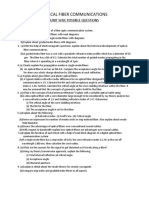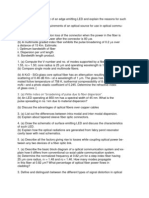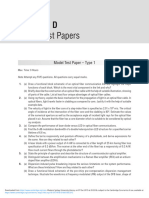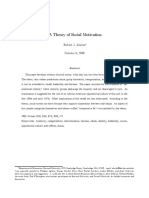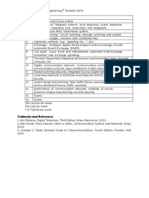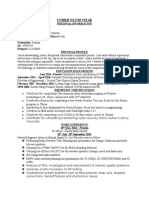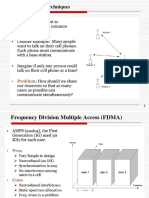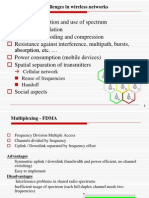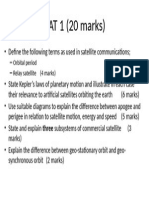0 ratings0% found this document useful (0 votes)
69 viewsKenyatta University Eee 509: Fibre Optic Communication Tutorial Questions
This document contains tutorial questions about fibre optic communication for a course. It includes questions that ask the student to: (1) draw a block diagram of a digital optical fibre communication system and explain each element; (2) outline advantages and disadvantages of optical fibre communication compared to other systems; and (3) define numerical aperture and explain its significance in fibre optic transmission. It also contains questions about calculating refractive indices, cut-off wavelength, attenuation causes, differences between step-index and graded-index fibres, dispersion types, and intrinsic and extrinsic absorption losses.
Uploaded by
Mtende MosesCopyright
© © All Rights Reserved
Available Formats
Download as PDF, TXT or read online on Scribd
0 ratings0% found this document useful (0 votes)
69 viewsKenyatta University Eee 509: Fibre Optic Communication Tutorial Questions
This document contains tutorial questions about fibre optic communication for a course. It includes questions that ask the student to: (1) draw a block diagram of a digital optical fibre communication system and explain each element; (2) outline advantages and disadvantages of optical fibre communication compared to other systems; and (3) define numerical aperture and explain its significance in fibre optic transmission. It also contains questions about calculating refractive indices, cut-off wavelength, attenuation causes, differences between step-index and graded-index fibres, dispersion types, and intrinsic and extrinsic absorption losses.
Uploaded by
Mtende MosesCopyright
© © All Rights Reserved
Available Formats
Download as PDF, TXT or read online on Scribd
You are on page 1/ 1
KENYATTA UNIVERSITY
EEE 509: FIBRE OPTIC COMMUNICATION
TUTORIAL QUESTIONS
a) Use a block diagram to describe the operation of a digital optical fibre
communication system and explain the function of each element in the link.
b) Outline advantages and disadvantages of optical fibre communication when
compared to other digital communication systems
c) State two conditions for total internal reflection to occur
d) By use of simple sketches, explain the three possible paths light rays can follow
inside a fibre-optic cable
e) Define Numerical Aperture and give its significance in the transmission of digital
signals in a fibre optic
f) Calculate the refractive indices of the core and cladding materials of an optical fibre
whose NA = 0.35 and = 1%.
g) Explain the meaning of cut-off wavelength of a step-index fibre
h) Find the cut-off wavelength for a step-index fibre to be operated as single-mode
fibre when the core refractive index is 1.46, relative refractive index difference is
0.25% and the core diameter is 9 m.
i) Explain three major causes of attenuation in optical fibre cables
j) Explain the difference between a step-index fibre and a graded-index fibre
k) A graded-index fibre having parabolic profile of refractive index has NA = 0.3 in
air and a core diameter of 60 m supports 742 guided modes. Calculate the
wavelength of light propagating in the fibre.
l) Differentiate between the following:
(i) Intermodal and intramodal dispersion
(ii) Rayleigh and Mie scattering
m) Distinguish between intrinsic and extrinsic absorption losses in optical fibre cables
and state the possible cause of each
You might also like
- Electronics & Communication Engineering R13 Iv-I Elective Ii Optical Communications (Rt4104A) Previous End Examination Questions (R13 & R10)No ratings yetElectronics & Communication Engineering R13 Iv-I Elective Ii Optical Communications (Rt4104A) Previous End Examination Questions (R13 & R10)7 pages
- Oc Unit Wise Possible Questions 1ST Mid &mid - IiNo ratings yetOc Unit Wise Possible Questions 1ST Mid &mid - Ii5 pages
- 6107 - Fiber Optic Communication SystemNo ratings yet6107 - Fiber Optic Communication System13 pages
- 6107 - Fiber Optic Communication SystemNo ratings yet6107 - Fiber Optic Communication System13 pages
- Optical Electronics Year III Semester 2.1No ratings yetOptical Electronics Year III Semester 2.13 pages
- Code: 9A04702: B.Tech IV Year I Semester (R09) Regular & Supplementary Examinations December 2015No ratings yetCode: 9A04702: B.Tech IV Year I Semester (R09) Regular & Supplementary Examinations December 20151 page
- Annauniversity Optical Communication Question PaperNo ratings yetAnnauniversity Optical Communication Question Paper7 pages
- Ec405 Optical Communication, December 2021No ratings yetEc405 Optical Communication, December 20212 pages
- (Schaum's Outline Series) Hwei Hsu-Schaum's Outline of Theory and Problems of Probability, Random Variables, and Random Processes-McGraw-Hill (1997)100% (1)(Schaum's Outline Series) Hwei Hsu-Schaum's Outline of Theory and Problems of Probability, Random Variables, and Random Processes-McGraw-Hill (1997)4 pages
- Note: No Additional Answer Sheets Will Be ProvidedNo ratings yetNote: No Additional Answer Sheets Will Be Provided2 pages
- (3 Hours) : :JO:9p-kett! (''I (Ornrn (Revised Course)No ratings yet(3 Hours) : :JO:9p-kett! (''I (Ornrn (Revised Course)1 page
- rr321002 Opto Electronic and Laser InstrumentationNo ratings yetrr321002 Opto Electronic and Laser Instrumentation5 pages
- C G1048 Pages: 2: Answer Any Two Full Questions, Each Carries 15 MarksNo ratings yetC G1048 Pages: 2: Answer Any Two Full Questions, Each Carries 15 Marks2 pages
- Tutorial 1: Sri Lanka Institute of Information Technology B.Sc. Special (Hons.) in Information TechnologyNo ratings yetTutorial 1: Sri Lanka Institute of Information Technology B.Sc. Special (Hons.) in Information Technology1 page
- University of Technology Department of Electrical Engineering Final Examination 2019-2020No ratings yetUniversity of Technology Department of Electrical Engineering Final Examination 2019-20203 pages
- Main Y4 SemII Fiber Optic Communication - 2013 - 3No ratings yetMain Y4 SemII Fiber Optic Communication - 2013 - 317 pages
- Organic Light-Emitting Transistors: Towards the Next Generation Display TechnologyFrom EverandOrganic Light-Emitting Transistors: Towards the Next Generation Display TechnologyNo ratings yet
- Grades For Moses Mtende - NDG Linux Essentials 1116mNo ratings yetGrades For Moses Mtende - NDG Linux Essentials 1116m2 pages
- EEE 546: Information Theory and SecurityNo ratings yetEEE 546: Information Theory and Security6 pages
- Ecu 500 - Engineering Practice and Ethics: Kenyatta UniversityNo ratings yetEcu 500 - Engineering Practice and Ethics: Kenyatta University2 pages
- Eee 545:satellite Communications: Danson NjueNo ratings yetEee 545:satellite Communications: Danson Njue28 pages
- Eee 545:satellite Communications: Satellite Motion and SpeedNo ratings yetEee 545:satellite Communications: Satellite Motion and Speed22 pages
- Eee 545:satellite Communications: Danson NjueNo ratings yetEee 545:satellite Communications: Danson Njue23 pages
- 2G SSV Verification: Huawei Technologies Co., LTDNo ratings yet2G SSV Verification: Huawei Technologies Co., LTD19 pages




